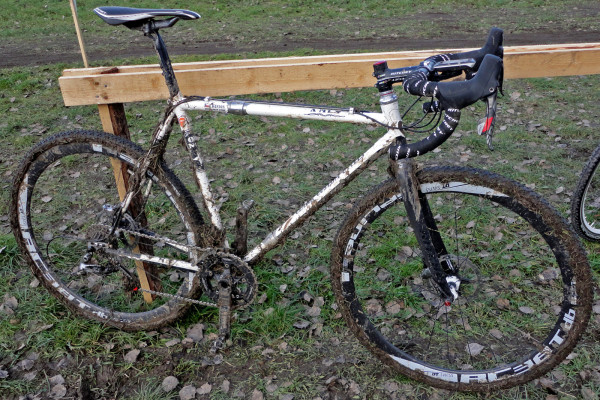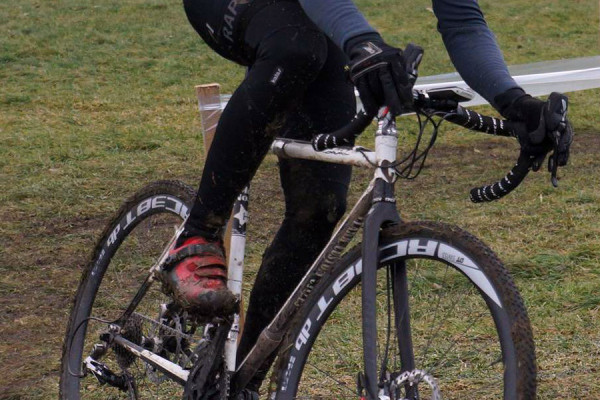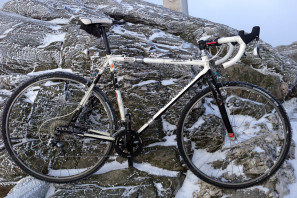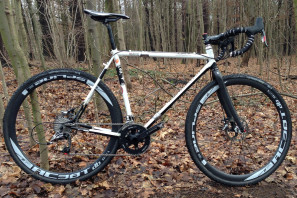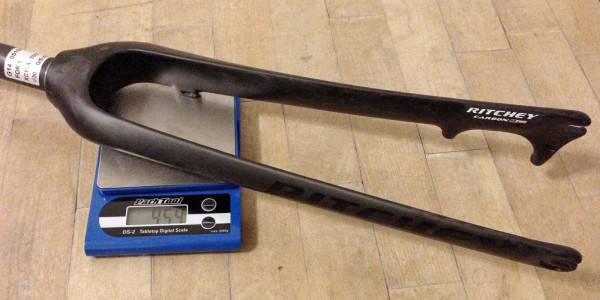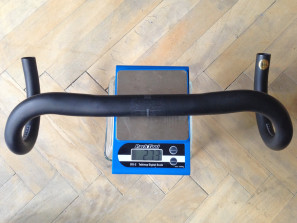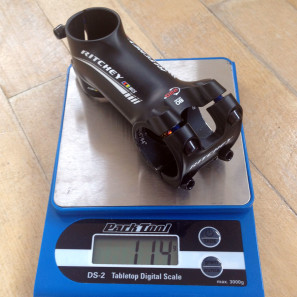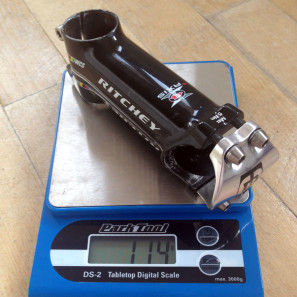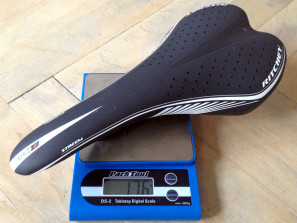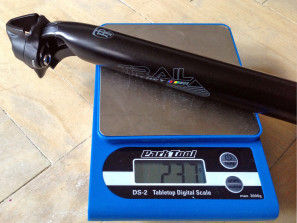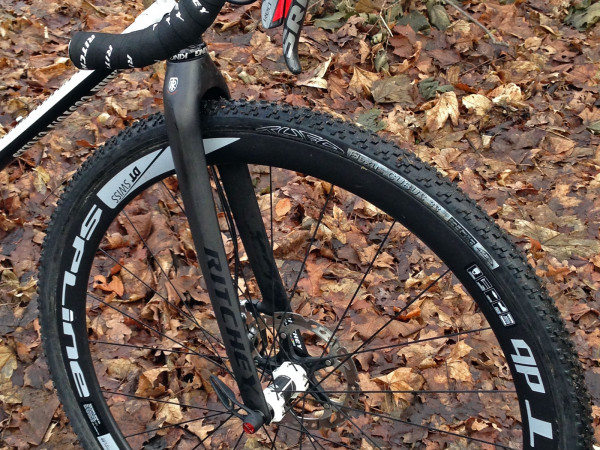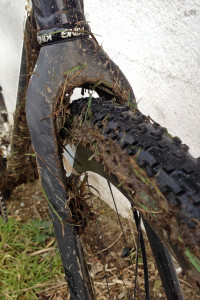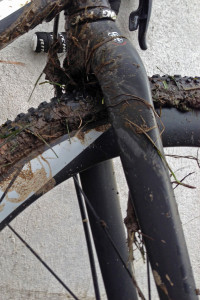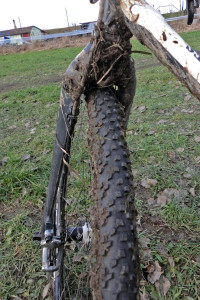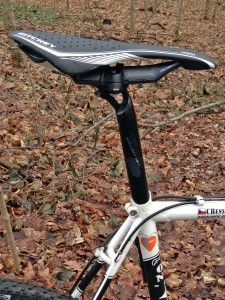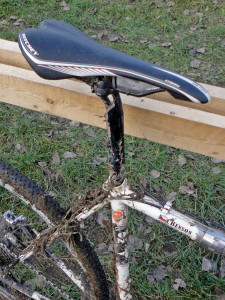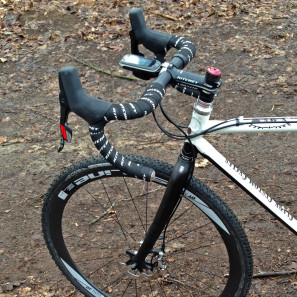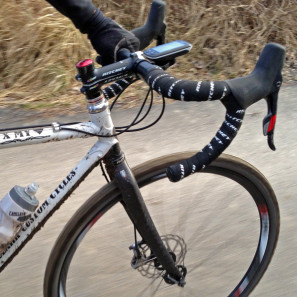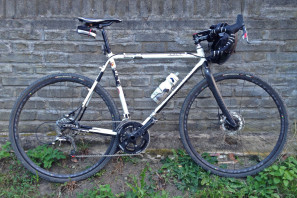Last week we took a look at a project bike which had been upgraded to disc brakes last winter for cyclocross season, before it got to spend the warmer weather all-around gravel and trail exploring. The bike served to give us the chance to torture test the SRAM Red Hydro R group that we reviewed last week. It’s also become a test mule for things like chainrings, tires, and different wheelsets, with more tests with it on the way. This time though, we focus on the one component that started the disc-brake conversion in the first place, the full carbon Ritchey WCS Disc Cross fork that we first spotted in Taipei. Then, since we’ve been happy with Ritchey Logic components on other personal bikes, we were happy to add a WCS cockpit to the bike by way of a Vector saddle and WCS aluminum seatpost, stem, and handlebars. Join us after the break for a walk-through of the disc brake conversion and our detailed piece-by-piece thoughts on the individual components…
Again a bit more background on the project, maybe 10 years ago I had this lugged steel Columbus Zona cross bike with S&S couplers and Paragon sliding dropouts made for me by, no longer in business, Clark Custom Cycles. It was set up from the start with an AlphaQ fork, Campagnolo drivetrain, and Paul cantis. It served me well in many an amateur and masters’ cyclocross race over the years, and has that lovely smooth ride that quality, top-level steel is known for. But its build had seen better days and warranted an update. At the same time, we’d been riding disc brake equipped cross bikes in races and on singletrack, and realized that the modular nature of the Paragon dropouts meant the frame was able to be swapped over to disc with a single new dropout slider. The issue then was finding a disc brake fork that would fit its 1 1/8″ headtube without sacrificing weight or race performance against the AlphaQ fork. The introduction of the full carbon, straight steerer Ritchey WCS Disc Cross fork was a perfect solution. We’d already had some time riding two different generations of Ritchey’s WCS canti cross fork, so were happy to try out the new disc brake version.
We stripped everything off the frame midway through cross season last year, swapped in the Paragon disc brake sliding dropout and Ritchey fork, then proceeded to build the bike back with Red HydroR, a Verve Infocrank power meter, the Ritchey cockpit, and an asortment of test wheels from DT, Novatec, and American Classic. We chose not to reconfigure the routing or remove the braze-ons (although keep an eye out for another similar project where we did that too), but just to see how simple the rebuild process would be, and whether it would be worth it on a traditional steel bike, when compared to the high-end carbon bikes we often review.
Since last winter the bike has ridden every surface there is short of a DH track, spent as much time in the snow and mud as it did on dry dirt and asphalt, and traveled a good bit throughout Central Europe riding back roads, trails, and racing cross. It’s become both the go-to bike for fun all-day adventures or cross races, and also the fall-back bike when any other bike has some issue or simply doesn’t have air in the tires.
Tech Details
The heart of the upgrade is the Ritchey WCS Carbon Disc Cross Fork. It retails for $400, and ours weighed 454g with an uncut 300mm steerer. The fork is a UD monocoque carbon affair with a straight 1.125″ carbon steerer tube, a 395mm long axle-to-crown, and 45mm of rake. The straight 1 1/8″ steerer makes it unique, as most other forks either use aluminum steerers or weigh significantly more or are just impossible to get a hold of. That all make this fork a great choice for the tons of old bikes out there that don’t have tapered headtubes and are in need of an upgrade.
The fork has a single zip-tie guide for external routing of the front brake, and comes with a carbon-friendly compression plug to clamp down the stem. It has aluminum threads bonded into the carbon post mount disc brake tabs, which are compatible with 140 or 160mm rotors, and a 45° crown race molded into the steerer. The bonded-on race somewhat limits the flexibility to use certain headsets. While the 45° race is pretty standard, it is not officially compatible with some, like the Chris King headset that we already had on the bike, which raises the front end of the bike about 2mm, and looks like it puts extra stress on the headset. As a result, we will likely replace the headset in the near future to remedy the issue.
The $100 WCS Evocurve handlebar is Ritchey’s short reach, shallow drop (83/128mm) bar with a tiny amount of backsweep on the tops and a subtle double-radius bend in the drops that can pass for being mostly round once it is wrapped. It is made from triple butted 7050 aluminum and has a no-slip textured finish at the standard 31.8mm oversized clamp and in the curve where the levers are mounted. Our matte black 42cm (c-c) bar weighed 273g. The bike has been ridden with two different stems through our tests to fit different riders. Both the 80mm WCS C220 and 100mm WCS 4-Axis 44 stems conveniently weighed in at the same 114g a piece, and have done their jobs without a second thought throughout this and other tests. We’ve used these stems on a number of other bikes as well, and they make up part of the basic kit we use to adjust all of our test bikes to different reviewers’ fit needs.
The saddle for this build is the $130 WCS Evo Vector Streem. It uses Ritchey’s own patented single, carbon reinforced plastic Vector Evo rail that claims to increases comfort and durability vs. traditional rails, and without a doubt adds plenty of adjustment range. The Vector rail connects at one spot in the front and two in the rear, much like a traditional set of rails to allow both the rail and shell to flex for comfort. The proprietary rail interfaces with the Vector Wing clamp of Ritchey’s Link seatpost for a secure two-bolt connection. The saddle itself has a 278mm long x 132mm wide flat profile that provides a good bit of surface to move back-and-forth on. The saddle’s shell is a combination of nylon and carbon fiber with a bit of designed-in lateral flex of the wings to move with the pedal stroke. It gets thin supportive padding across its top and a seamless, perforated synthetic leather cover. Our saddle sample weighed just 176g.
The Link seatpost we used is a $90 27.2mm WCS Alloy Trail model with 15mm of offset, weighing 237g. While branded as a mountain bike component, it uses the same 3D forged 7050 aluminum construction as the road and cross versions, although with an open machined-out head that may actually make it lighter. The Trail also comes in 400mm lengths only, while the road version gets a 350mm option. All of the Link seatposts (there are carbon versions that drop almost 100g) use the interchangeable heads that offer clamps for standard round or oval rails, Ritchey’s Vector rail, or Selle Italia’s Monolink rails. For comparison, the Vector clamp makes up 54g of the overall weight of the post vs. 63g for the normal head. The individual clamp kits sell for an additional $14-20, but sometimes comes with the Ritchey Vector saddles.
Review: Racing and Riding
Putting the bike together was pretty simple with respect to the Ritchey components. But as mentioned above the 45° bearing race molded into the fork crown added a little hiccup. Since we had decided to stick with the King headset for the time being, the result was a ~2mm gap between the top of the fork crown and the bottom of the headset cup. In order to keep this area from collecting water, dust, and mud we installed a rubber o-ring that acts effectively as a seal, closing the gap. It has since managed to keep debris from contaminating the lower headset bearing, and we’ve had no other issues so far. That being said, we would recommend using a headset designed for the 45° bearing contact, and plan to do the same thing ourselves before cross season gets sloppy again this year. Otherwise, setup was easy; the rest of the components are all aluminum (less fear about breaking in the rough treatment of cross racing), so a simple setup with a torque wrench from day one and nothing has moved on us.
At least five different wheelsets have been clamped onto the fork in the last year with a number of different quick release clamps. The DT Swiss RWS skewers above had probably the most secure feel, although followed closely by the the internal cam QRs of Hunt Wheels. The least clamping force were probably the light QRs from American Classic, but even with those, disc brakes, and the vertical carbon dropouts of the Ritchey fork we had no clamping/ejection issues.
The fork spent most of its early days trudging through mud and wet slippery grass. Clearance around UCI-max 33mm tires isn’t huge, but always seem to be plenty. In the worst days we had mud and grass build up on the back of the fork crown, especially around the zip-tied brake cable, with grass also wrapping itself around the fork legs and accumulating. But even thicker heavy mud seemed to build up only on the back of the fork and never really impeded the movement of the wheel. That being said, we never put a tire bigger than a 35mm cross tire in the fork, and then only in dry weather.
The fork feels precise for a something with a quick release axle. There was certainly a noticeable difference in our first dry races when taking corners at high speed through roots and ruts vs. the tapered forks and thru-axles of some of the top-end bikes we tested last year. With that said, once it got cold, wet, and muddy the ability to differentiate them seemed to diminish dramatically. But what we would take away is that the fork has a more forgiving fore-aft feel than the AlphaQ CX20 that it replaced or most tapered carbon race forks. Steering precision has remained, but we are less beat up after a race, and the bike is more comfortable to ride on all-day gravel road or trail adventures.
The Vector Streem saddle has a fairly rigid feel to it when we first hopped aboard, but this seems mostly a result of the minimal padding. Taking a second to push on the saddle, it is very apparent how much give there is in the shell, the flex in the wings, and the ability for the entire saddle to deform side-to-side as a result of the Vector rail’s contact with the shell at the rear of the saddle. We’ve jumped onto this seat many times in race situations, and haven’t had any issue yet. The long, flat shape has been good for adjusting my position around to keep cranking on the pedals even when the legs were done. The standard rounded off back makes this a better fit for cross than the Arione which I prefer on the road for its long, flat shape.
The single Vector rail claims better compliance vs. traditional carbon-railed saddles. While that is a subjective sounding claim, we can back it up saying that for a 410g saddle/post combo, this one is decidedly comfortable and has taken our abuse in stride. Whether or not the single rail absorbs energy and diffuses stress as it claims is certainly not something we could answer objectively. What we can say is that the Vector clamp is secure. In almost a year of riding and racing the clamp has not moved from where it was set. On top of that, we can only recall two instances when the clamp made any noise at all, both on poorly executed remounts with sky-high heart rates at race pace. Neither time did the saddle move, nor was there any evidence of damage.
The only negative we have to say about the saddle is with regards to its proprietary nature. We actually hate when one part is not compatible with the next. It was welcome that the Trail Link seatpost fits normal railed saddles as well, and that our Streem saddle included the Vector Link clamp. That being said, we don’t have any other seatpost that will hold this saddle, so it will never spend any time on all the other bikes we ride that don’t use a 27.2 post. Plus, the single rail layout means that no standard saddle bag can be strapped under the seat securely, seriously limiting the ability to do longer off-season training and exploring rides. Luckily by chance we had a Scicon saddle bag with their removable roller clamp that we could jamb into the back of the Vector rail and clamp in place, but if you don’t have this one bag, you are out of luck.
During our review period the bar/stem combo has completely disappeared from our thoughts after setting the bar to be able to comfortably ride both on the big SRAM hoods or in the long drops. The alloy Evocurve bar has given plenty of comfortable hand positions and survived all of the minor tumbles we’ve subjected it to. The bar does not stand out as being overly stiff or having a harsh ride, but also hasn’t ever feel loose or noodly. Both stems have held the bar in place, and the WCS Logic EVA bar tape has stayed out and provided plenty of vibration dampening grip both wet and dry, with gloves and without.
The fact that the bar-stem interface hasn’t slipped in the last 9 months actually impressed me. We installed it without friction paste, due to the textured clamp area on the bar, and it has stayed put. Just this last weekend I put around 100km of off-road riding on the bike over two days on singletrack that was much more beaten up than last time I’d ridden it a year ago on a mountain bike. In the meantime increased traffic on the trail has made for a lot of stutter bumps and washboard sections that I hit going pretty quickly. Several times I would push through a fast turn only to get beaten up and wonder when the bar would slip, but it never did. It was bad enough that I had to stop the second day mid ride and stretch my back and shoulders in order to finish the ride. But the bar and levers stayed put where they belonged, without needing to be over-torqued.
As a whole the Ritchey fork and cockpit components have proved themselves to be an excellent balance of performance, lightweight and durability. Put together this selection does a good job of saving weight where there are performance gains from the premium components, and using solid aluminum parts where durability is key. The full carbon fork reaps the benefit of being engineered to absorb some fore-aft impacts through its curved legs and directional layup, while retaining lateral stability and subsequently solid handling. We’ve been so pleased with the fork performance in fact, that we are going to get ahold of another one for a similar steel disc brake conversion to be set up with Shimano Ultegra Di2 for this cross season. The light Vector-railed saddle also does a good job of offering comfort through designed-in flex. Then the aluminum bar, stem, and post hold everything where it should be and stand up to being tossed on the ground in races, pits, and in the parking lot before heading home
More than half way through our test we also got ahold of a set of Ritchey’s WCS Zeta Disc wheels to add to the review. We haven’t had enough time on them yet to offer a definitive review, but the first impressions seem very good. The centerlock wheels use a fairly wide asymmetric rim and set up tubeless with a pair of Hutchinson Toro tires faster and easier than any combo we’ve ever tried (with a regular floor pump, without even removing the valve core.) We’ve successfully been trail riding that setup down to around 26psi without any problems yet, so needless to say we are curious how low we can go now that cross season is here. We’ll report back when we find their limits.
